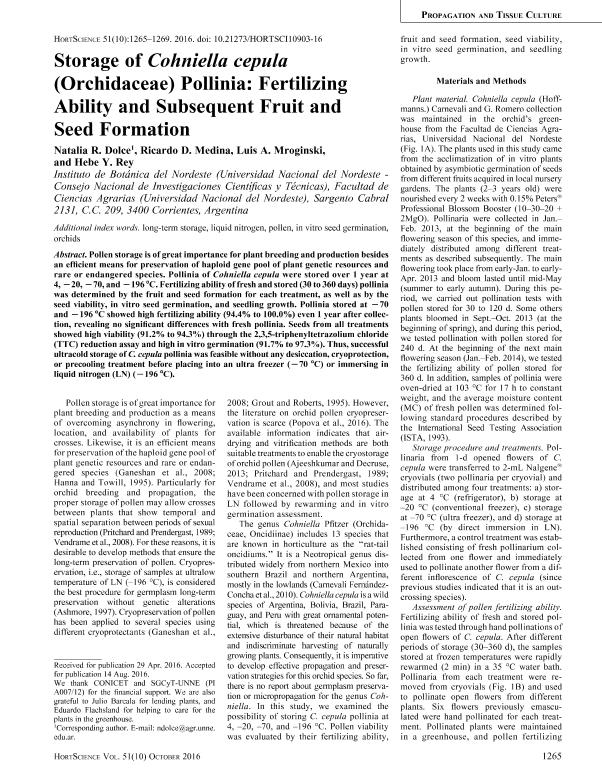Artículo
Storage of Cohniella cepula (Orchidaceae) Pollinia: Fertilizing Ability and Subsequent Fruit and Seed Formation
Fecha de publicación:
08/2016
Editorial:
American Society for Horticultural Science
Revista:
Hortscience
ISSN:
0018-5345
e-ISSN:
2327-9834
Idioma:
Inglés
Tipo de recurso:
Artículo publicado
Clasificación temática:
Resumen
Pollen storage is of great importance for plant breeding and production besides an efficient means for preservation of haploid gene pool of plant genetic resources and rare or endangered species. Pollinia of Cohniella cepula were stored over one year at 4, -20, -70, and -196 ºC. Fertilizing ability of fresh and stored (30 to 360 days) pollinia was determined by the fruit and seed formation for each treatment, as well as by the seed viability, in vitro seed germination, and seedling growth. Pollinia stored at -70 and -196 ºC showed high fertilizing ability (94.4 to 100.0%) even one year after collection, revealing no significant differences with fresh pollinia. Seeds from all treatments showed high viability (91.2 to 94.3%) through the 2,3,5-triphenyltetrazolium chloride reduction assay and high in vitro germination (91.7 to 97.3%). Thus, successful ultra cold storage of C. cepula pollinia was feasible without any desiccation, cryoprotection, or precooling treatment before placing into an ultra freezer (-70 ºC) or immersing in LN (-196 ºC).
Palabras clave:
Long-Term Storage
,
Liquid Nitrogen
,
Pollen
,
In Vitro Seed Germination
,
Orchids
Archivos asociados
Licencia
Identificadores
Colecciones
Articulos(IBONE)
Articulos de INST.DE BOTANICA DEL NORDESTE (I)
Articulos de INST.DE BOTANICA DEL NORDESTE (I)
Citación
Dolce, Natalia Raquel; Medina, Ricardo Daniel; Mroginski, Luis Amado; Rey, Hebe; Storage of Cohniella cepula (Orchidaceae) Pollinia: Fertilizing Ability and Subsequent Fruit and Seed Formation; American Society for Horticultural Science; Hortscience; 51; 10; 8-2016; 1265-1269
Compartir
Altmétricas




